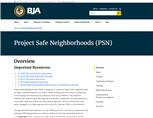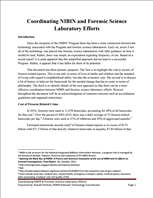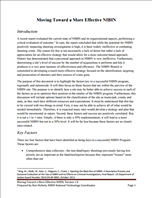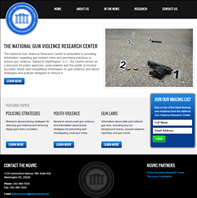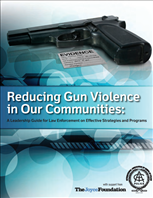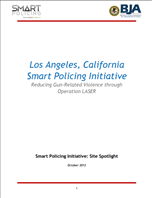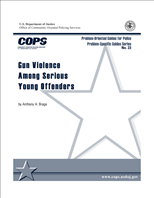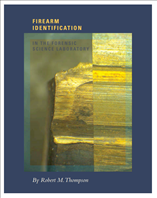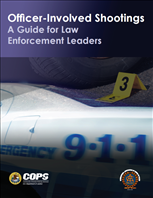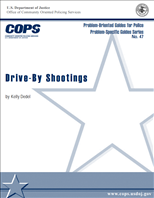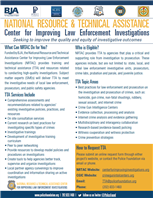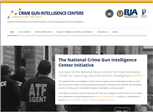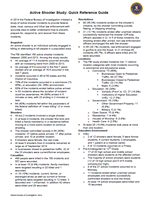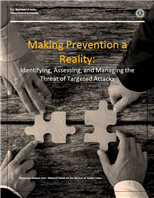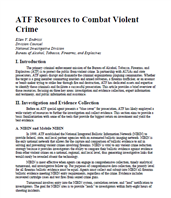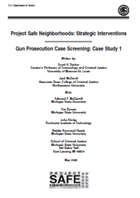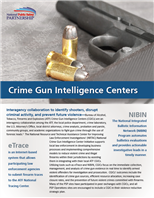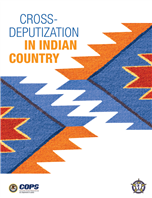BJA Project Safe Neighborhoods
Project Safe Neighborhoods (PSN) is designed to create and foster safer neighborhoods through a sustained reduction in violent crime, including, but not limited to, addressing criminal gangs and the felonious possession and use of firearms. The program's effectiveness depends upon the ongoing coordination, cooperation, and partnerships of local, state, tribal, and federal law enforcement agencies--and the communities they serve--engaged in a unified approach led by the U.S. Attorney (USA) in all 94 districts.
ALERRT Civilian Response to Active Shooter Events Train-the-Trainer
Law enforcement officers and agencies are frequently requested by schools, businesses, and community members for direction and presentations on what they should do if confronted with an active shooter event. The Civilian Response to Active Shooter Events (CRASE) course, designed and built on the Avoid, Deny, Defend (ADD) strategy developed by ALERRT in 2004, provides strategies, guidance, and a proven plan for surviving an active shooter event. Topics include the history and prevalence of active shooter events, civilian response options, medical issues, and considerations for conducting drills. Participants in this four‑hour Train-the-Trainer course will receive a manual and Power Point presentation suitable for use in their own presentations.
ALERRT Medical Advanced Skills Course
ALERRT introduced a new 8 hour Medical Advanced Skills Course (MASC) in 2018/2019 intended to provide medical first responders with best practices for the management of traumatic injured patients to enhance survivability and combat potentially preventable death specifically from active attacker events. Topics will include Pre-Hospital Damage Control Resuscitation (DCR), Compressible and Non-Compressible Bleeding Management, Hypotensive Resuscitation, Hemostatic Resuscitation, Airway Management, Tension Pneumothorax Management, Hypothermia Prevention and Management.
ALERRT Active Shooter Incident Management
This course provides participants an overview of the Incident Command System and its specific application to integrate and manage the law enforcement, fire, and EMS response to Active Shooter Events. The course prepares responders to manage the first hour of response to Active Shooter Events ranging from Basic Complexity to Complex Simultaneous Coordinated Attacks. Hands-on exercises simulate unpredictable Active Shooter Events in real time scenarios that enable learning and practice while improving effectiveness and officer safety as part of the VALOR officer safety initiative.
Coordinating NIBIN and Forensic Science Laboratory Efforts
This document has three primary purposes. The first is to highlight the cost to society of firearm-related injuries. This is not only in terms of lives of adults and children and the standard of living with regard to neighborhood safety, but also the economic cost. The second is to discuss a bit of history to help set the framework for the needed change that has to come in terms of philosophy. The third is to identify details of the new approach so that there can be a more effective coordination between NIBIN and forensic science laboratory efforts. Weaved throughout the document will be an acknowledgment of common concerns such as accreditation guidelines and supposed restrictions.
Moving Toward a More Effective NIBIN
The purpose of this document is to highlight the factors key to a successful NIBIN program, regionally and nationwide. It will then focus on those factors that are within the purview of the NIBIN site.
National Gun Violence Research Center
The National Gun Violence Research Center is dedicated to providing information regarding gun-related crime and promising practices to reduce gun violence. Based in Washington, D.C., the Center serves as a resource for police agencies, policymakers and the public to receive accurate, timely and nonpartisan information on gun violence and about strategies and policies designed to reduce it.
NIBIN Frequently Asked Questions
Frequently Asked Questions regarding ATF's National Integrated Ballistics Information Network
Reducing Gun Violence in Our Communities: A Leadership Guide for Law Enforcement on Effective Strategies and Programs
The overall goal of this guide is to provide information about notable programs and policing strategies that can be implemented by law enforcement agencies, regardless of size, in order to enhance the critical and life-saving mission of reducing gun violence. By highlighting innovative approaches developed by law enforcement departments and communities across the country, local leaders are encouraged to expand upon their current efforts in order to create a comprehensive program to enhance community and officer safety. The guide is structured with sections that address many existing gun violence problems including: gangs, youth violence, domestic violence, and federal firearms trafficking. If a community is experiencing a particular form of gun violence, the corresponding section of the guide offers practical information on effective countermeasures and ways to involve the community, as appropriate. Local law enforcement agencies, together with community leaders, can review this guide to learn about proactive programs and strategies that can be replicated and/or customized to fit into an individual agency’s policing model.
Reducing Gun-Related Violence through Operation LASER
The Los Angeles Smart Policing Initiative (SPI) sought to reduce gun-related violence in specific neighborhoods in the city of Los Angeles, through application of the SARA problem-solving model—Scanning, Analysis, Response, and Assessment. As part of the scanning phase, the LAPD and its research partner examined gun-related crimes by Division and by Reporting District for 2011. In 2011, the Newton Division was ranked third in gun violence among the 21 Divisions.
SMART Approaches to Reducing Gun Violence
This Spotlight report reviews the common strategies that police have employed across nine sites. These evidence-based strategies, which reflect core tenets of the Smart Policing Initiative (SPI), are grounded in a risk-focused framework that recognizes the importance of targeting efforts on the places, people, and times at greatest threat of violence.
Gun Violence Among Serious Young Offenders
This problem-specific guide addresses gun violence among serious young offenders. The guide is divided into three main areas: (1) the problem of gun violence among serious young offenders which includes related problems and factors contributing to gun violence among serious young offenders; (2) understanding the local problem by asking the right questions and measuring effectiveness; and (3) responses to the problem of gun violence among serious young offenders including offender-oriented responses, place-oriented responses, and responses with limited effectiveness. The report also presents a summary of responses to gun violence among serious young offenders, the mechanisms by which they are intended to work, the conditions under which they ought to work best, and some factors that should be considered before implementing a specific response.
Firearm Identification In The Forensic Science Laboratory
This monograph serves to introduce the prosecutor to the principal elements of one of the forensic specialties, the science of "firearm and toolmark identification." For a prosecutor to be successful, he or she must be cognizant of the expectations of today's jury. Thanks to the modern electronic media, use of the forensic sciences has caught the imagination of the public, and the potential jury pool has demonstrated that it has certain expectations when a case is brought before it. No matter how fantastic or erroneous these expectations are, practitioners in law enforcement and experts in the forensic sciences have to deal with them in a forthright manner. The best strategy is for the prosecutor to be well acquainted with the capabilities and limits of the forensic science disciplines that may be the linchpin in the investigation and, more importantly, in the prosecution of a defendant at trial.
Officer-Involved Shootings: A Guide for Law Enforcement Leaders
Though few officers will be directly involved in a hostile shooting situation during their careers, many more may experience the impact of one; the effects of such events touch not only the officer involved, but the department and the community as well. Because of the gravity of officer-involved shootings, it is vitally important to ensure that the agency and its officers are prepared in advance for such an event. This guide is intended to provide guidance for preparing officers and departments prior to an officer-involved shooting, suggested incident scene actions and procedures, recommended procedures for conducting criminal and administrative investigations, suggestions for working with the media, and mental health and wellness considerations and procedures.
Drive-By Shootings
This guide begins by describing the problem of drive-by shootings and reviewing factors that increase its risks. It then identifies a series of questions to help you analyze your local drive-by shootings problem. Finally, it reviews responses to the problem and what is known about them from evaluative research and police practice.
Denver's Crime Gun Intelligence Center
This film is about a unique collaboration of federal and local law enforcement and prosecutors in Denver which targets both those who commit gun crimes and those who illegally sell the weapons used in the crimes. This film is for informational or educational purposes only.
Denver Crime Gun Task Force
A unique law enforcement collaboration in Denver targeting gun crimes by using real-time forensic ballistic information to tie crimes together to help reduce violent crime.
National Resource & Technical Assistance Center for Improving Law Enforcement Investigations
Funded by BJA, the National Resource and Technical Assistance Center for Improving Law Enforcement Investigations (NRTAC) provides training and technical assistance (TTA) and resources related to conducting high-quality investigations. Subject matter experts (SMEs) will deliver TTA to meet the investigative needs of local law enforcement, prosecutors, and public safety agencies. TTA Services Include: • Comprehensive assessments and recommendations related to agencies’ existing investigative policies, practices, and resources • On site consultation services • Current research on best practices for investigating specific types of crimes • Investigative trainings • Development of investigative training curriculum • Peer to peer networking • Provide resources to develop model policies and procedures on investigations • Create tools to help agencies better track, supervise and organize investigations • Local partner agency convenings to improve coordination and information sharing on active investigations
Police Critical Incident Checklist
This section contains a checklist to prepare police officials for responding to a critical incident that has the potential to result in controversy or conflict involving the police and a community. Because a critical incident typically requires a police department to quickly undertake a wide range of actions, straining the capacity of the department, a checklist can help to ensure that officials consider all potential options ahead of time, and that certain tasks do not “fall through the cracks” during an incident. This checklist is not meant to be a comprehensive list of steps or a rigid timeline for a police response, but rather is intended to serve as a guide to many of the issues that police should consider before, during, and after a critical incident that results in community tension. The immediate response of a police executive can determine how the community will respond to an incident, and can set the tone for the department’s ongoing relationship with the community in the long-term. This checklist emphasizes actions that can help calm tensions and demonstrate good faith to the community.
Crime Gun Intelligence Training – Including NIBIN and Firearms Tracing
Most ATF offices can provide customized, peer-to-peer training. For those tasked with ‘first responder’ functions, this training can be focused on the why and how of comprehensive collection of ballistic evidence and the value of firearms tracing, rather than how to conduct follow up investigations. For those tasked with investigative responsibilities, the training can focus on how to use crime gun intelligence to conduct investigations.
ATF Training Resources
ATF regularly presents training for Special Agents at various locations across the country, and the training sessions typically include space for attendance by officers from other Federal, State, and local law enforcement agencies. Agencies can contact their local ATF office to determine scheduling and availability. Topics include: Basic Undercover Operations, Advanced Undercover Operations, Rural Tactical Operations, Social Media, Cell Phone Exploitation, Firearms Trafficking and FFL Burglaries, Gang-Related RICO Investigations, and Officer Safety and Armed Individuals.
The National Crime Gun Intelligence Center Initiative
The National Crime Gun Intelligence Center Initiative supports local multidisciplinary teams in their efforts to prevent violent crime by identifying perpetrators, linking criminal activities, and identifying sources of crime guns for immediate disruption, investigation, and prosecution. These efforts and others are all components of Crime Gun Intelligence Centers (CGICs), an innovative and collaborative concept developed by the Denver Police Department and the U.S. Department of Justice’s Bureau of Alcohol, Tobacco, Firearms and Explosives (ATF).
FBI Law Enforcement Enterprise Portal
The FBI's Law Enforcement Enterprise Portal (LEEP) is a gateway providing law enforcement agencies, intelligence groups, and criminal justice entities access to beneficial resources. These resources will strengthen case development for investigators, enhance information sharing between agencies, and be accessible in one centralized location.
Active Shooter Quick Reference Guide
In 2014 the Federal Bureau of Investigation initiated a study of active shooter incidents to provide federal, state, local, campus and tribal law enforcement with accurate data to better understand how to prevent, prepare for, respond to, and recover from these incidents.
Making Prevention a Reality: Identifying, Assessing, and Managing the Threat of Targeted Attacks
This guide first addresses some important awareness aspects of the active shooter problem, not the least of which is the term “active shooter.” The content of this publication does not begin and end with active shooters, but instead applies to targeted violence generally. However, it does not specifically address potential acts of terrorism, or threat assessment for violence perpetrated primarily in furtherance of a political, religious, or other extremist cause or ideology. Planned violence, threat assessments, violence and mental health, and barriers to successful prevention efforts are also discussed. The guide then offers specific and actionable information on identifying, assessing, and managing persons who pose a true concern for planned, targeted violence. Guidance about setting up and running a threat management team is offered. Sample tools are provided in the appendices.
ATF Resources to Combat Violent Crime
The primary criminal enforcement mission of the Bureau of Alcohol, Tobacco, Firearms, and Explosives (ATF) is to protect the public from violent crime. In partnership with AUSAs and state prosecutors, ATF agents disrupt and dismantle the criminal organizations plaguing communities. Whether the target is a gang member committing murders and armed robberies, a firearms trafficker, or an arsonist or bomb maker trying to strike fear through fire and destruction, ATF has dedicated assets and expertise to identify those criminals and facilitate a successful prosecution. This article provides a brief overview of those resources, focusing on three key areas: investigation and evidence collection, expert information and testimony, and public information and assistance.
Project Safe Neighborhoods Case Study: Gun Prosecution Case Screening
A series of promising practices and interventions has emerged in PSN sites across the country. Not all are utilized in all PSN sites, and those that are implemented are adapted to fit local contexts.Yet, these strategic interventions and practices are being utilized by a number of PSN task forces with promising results. The initial set of PSN case studies focuses on four of these practices: crime incident reviews, gun prosecution case screening, chronic violent offender lists, and offender notification meetings. The current study focuses on gun case screening.
ATF Police Officer's Guide to Recovered Firearms Mobile Application
The Project Safe Neighborhoods Initiative in partnership with the Bureau of Alcohol, Tobacco, Firearms & Explosives (ATF) and Bureau of Justice Assistance (BJA) developed a mobile application as a proactive gun violence prevention strategy and tool. The ATF Police Officer's Guide to Recovered Firearms mobile application is designed to assist law enforcement in firearm identification, trace, recovery and safety. Utilizing the app, law enforcement officials will receive strategies to enhance firearm safety, a visual guide for accuracy in firearm identification and a collection of tips, policies and procedures to assist in firearms investigations. The ATF Firearms app is a helpful resource as investigative priorities focus on targeting armed violent offenders and career criminals, narcotics traffickers, narco-terrorists, violent gangs, and domestic and international arms traffickers.
Federal Letter of Intent to Prosecute (FLIP) Letter Template
This template is a resource for United States Attorneys to document federal intent to prosecute a defendant currently pending in a local/state case related to possession of a firearm by a prohibited person. This letter from the United States Attorney and/or Assistant United States Attorney should be shared with the local prosecutor (state or county) that is handling the case. This letter in notifies the prosecutor and defendant that the United States will proceed with federal prosecution of the defendant if the pending case is not resolved in a manner satisfactory to the prosecutor's office.
Crime Gun Intelligence Centers Guide
This document provides background on CGIC processes and includes a peer exchange sample guide and additional resources. Agencies interested in learning more about CGICs may find it helpful to visit an agency with an established program in a peer learning opportunity.
Cross-Deputization in Indian Country
This report - based on the work of the National Sheriffs' Association, which assembled a cross-deputization advisory panel - examines the jurisdictional and legal limits of cross-deputization and how it has been implemented in various law enforcement agencies in Indian country. It also describes some of the most promising practices and provides sample documents and agreements.
